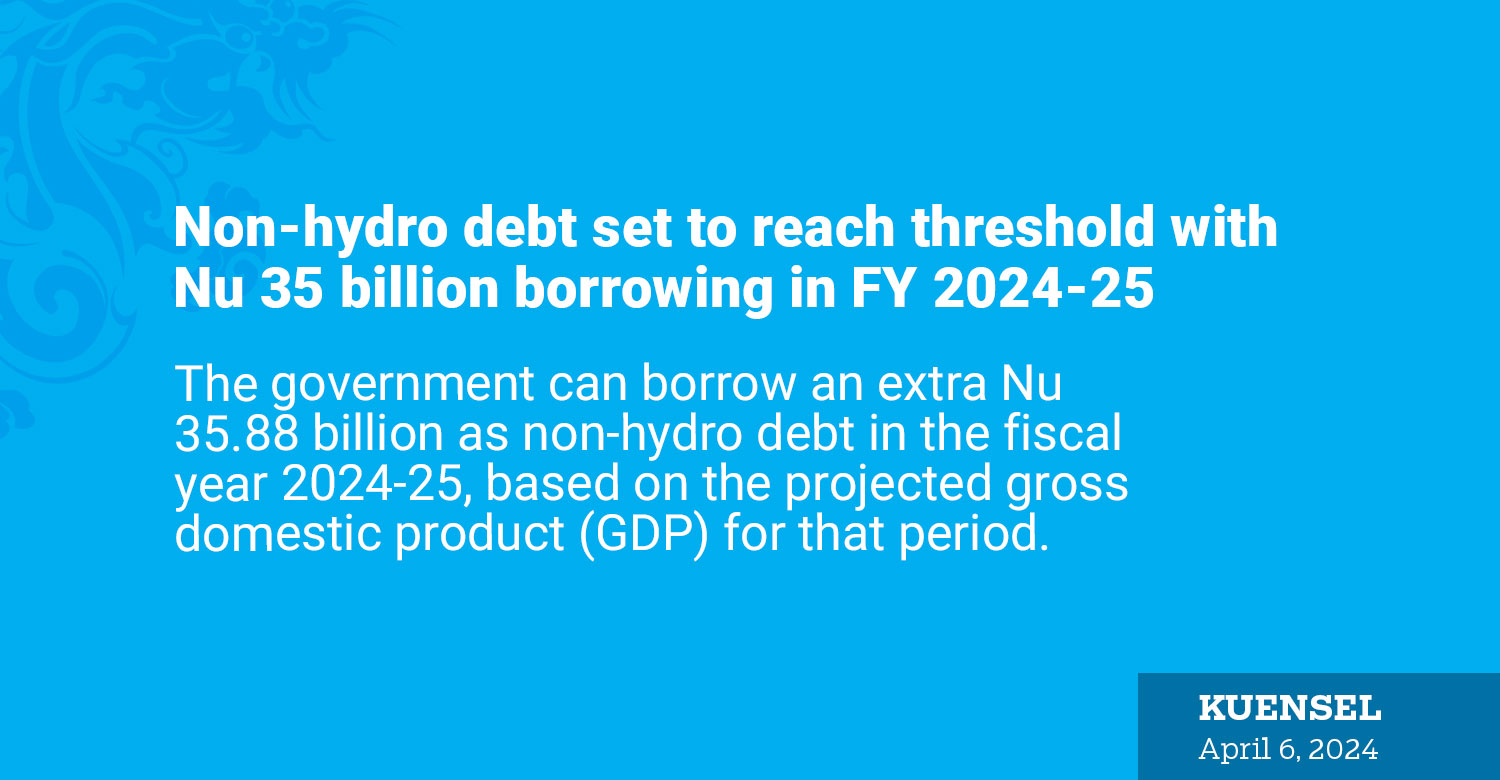…non-hydro debt grew by over 60 percent in last three years
Thukten Zangpo
The government can borrow an extra Nu 35.88 billion as non-hydro debt in the fiscal year 2024-25, based on the projected gross domestic product (GDP) for that period.
Last year, the non-hydro debt reached Nu 94.32 billion, representing 34.8 percent of the estimated GDP for that year. This amount constitutes 33.7 percent of the national debt.
According to the Public Debt Management Policy 2023, which requires that the non-hydro debt should not exceed 55 percent of GDP annually, the government could potentially borrow up to Nu 130.19 billion in the fiscal year 2024-25.
This is estimated based on the finance ministry’s mid-year GDP of last year.
This indicates that the government could potentially borrow an additional Nu 35.88 billion in fiscal year 2024-25, which amounts to 20.2 percent of the GDP estimates for that year.
In fiscal year 2025-26, the government can borrow up to Nu 143.5 billion. For the subsequent fiscal years of 2026-27 and 2027-28, the borrowing capacity increases to Nu 155.32 billion and Nu 167.75 billion, respectively.
The increasing non-hydro debt has become a pressing issue for the country. Over the past three years, it has surged by 65.13 percent. The non-hydro debt stood at Nu 57.12 billion in 2020, which climbed to Nu 60.23 billion in 2021, and further increased to Nu 73.22 billion in 2022.
The government resorts to borrowing to cover the financing gap in the budget, known as the budget deficit. It does so through both external and domestic financing channels, where the resulting liabilities are directly attributed to the government.
This financing is categorised as capital expenditure because the Constitution mandates that the government must cover recurrent expenditure using internal resources of the country.
In the 13th Plan, the government has set an ambitious goal of doubling the GDP to USD 5 billion by 2029. To achieve this target, it has established a goal of growing the GDP at an average rate of 8 percent annually.
For the 13th Plan, with an estimated total resource of Nu 363.91 billion and total expenditure projected at Nu 404.51 billion, the fiscal balance is anticipated to be around 3 percent of GDP or Nu 40.6 billion.
The draft 13th Plan estimates a gross financing requirement of Nu 91.19 billion. This includes Nu 13.51 billion from external borrowings and Nu 77.68 billion from domestic borrowings.
As part of a prudent financing strategy, prioritising borrowings from external concessional sources is recommended due to their lower financing costs.
If a significant portion of revenue is allocated to debt servicing, it could constrain funds available for public investments, including crucial social and developmental projects, potentially leading to a situation known as “debt overhang”.
To mitigate this risk, it’s essential to explore alternative methods of revenue mobilisation, effectively manage grants, enhance exports, and attract foreign direct investments.
As of last year, the total debt stood at Nu 279.93 billion, comprising Nu 251.83 billion in external debt and Nu 28.1 billion in domestic debt.
The Public Debt Policy also allows for the possibility of exceeding the debt threshold during an economic crisis.
However, such actions require the government to officially declare emergencies and inform the next Parliament session of the circumstances, along with plans to stabilize debt levels and ensure timely servicing to meet the required threshold.


